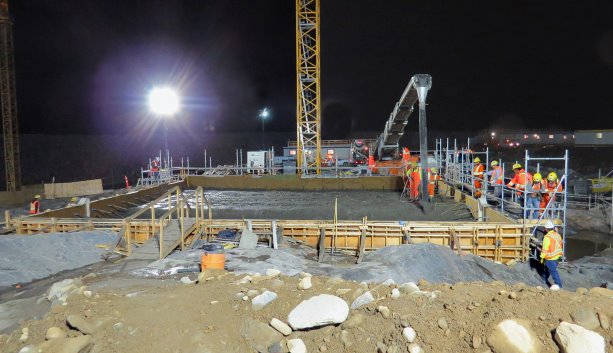The concrete pour on the spillway structure for the Muskrat Falls hydroelectric generating facility in Labrador is underway as construction takes a significant step forward on the Lower Churchill Project.
"Over the course of 2014, Astaldi Canada, our prime civil contractor, has mobilized the site and are establishing their organization," said Gilbert Bennett, Nalcor Energy vice-president of the Lower Churchill Project.
"They have been getting their batch plant crushing facilities in place, getting organized with form work and getting their reinforcing bar in place. And, now they are at the point where they have started pouring concrete. They have a lot of concrete to pour."
Nalcor announced on Aug. 18 that the Muskrat Falls Project had reached another significant milestone for construction with the first concrete pour.
"Through the course of 2013, we completed the excavation for the powerhouse and spillway at Muskrat Falls, which took most of the year," said Bennett.
"Over the course of the year we removed about 2.2 million cubic metres of rock from the powerhouse and spillway excavation, so we could get ready for the concrete, and that got us to what we are doing this year."
The powerhouse and intake structure at the Muskrat Falls will be about 85-metres high and the project will have two dams. Concrete work is required for the spillway, powerhouse and dam structures.
The powerhouse will consist of four units, each housing a turbine and generator. When the concrete substructure and steel superstructure for the powerhouse have been constructed, a powerhouse crane will be erected and the four turbines and generators will be installed in sequence.
The north dam will be 32-metres high and 432-metres long and the south dam will be 20-metres high and 325-metres long. The two dams combined will be longer than seven CFL (Canadian Football League) football fields.
The north dam will be constructed using a special high-density concrete, known as roller-compacted concrete. The concrete mix is spread by bulldozers, and then compacted by compaction rollers into a series of horizontal layers.
The south dam will be a conventional rock-filled dam that will be constructed by building up layers of rock and till material on the underlying bedrock, which will serve as a foundation for the dam. A road will also be built at the top of the dam to provide access.
The powerhouse and spillway structures will require 560,000 cubic metres of concrete. An additional 200,000 cubic metres is required to build the dams.
Phase 1 of the Lower Churchill Project involves the construction of three main components. These are:
— an 824 MW hydroelectric facility at Muskrat Falls on the lower Churchill River in Labrador;
— more than 1,500 km of associated transmission lines in Newfoundland and Labrador linking the island of Newfoundland to Labrador; and
— the Maritime Link (ML) between the island of Newfoundland and Nova Scotia.
The hydroelectric facility and the transmission lines in Newfoundland and Labrador are being constructed by Nalcor and the ML is being constructed by Emera Inc.
Since construction of the Muskrat Falls Project began in 2012, work has started as planned on all major sites for the project, including Muskrat Falls, Soldiers Pond, Churchill Falls, the Strait of Belle Isle and the transmission routes.
During construction, work is taking place seven days/week, using two, 10-hour shifts each day.
In June, almost 3,000 people were working on the project of which about 86 per cent were from Newfoundland and Labrador.
An accommodation complex was established on the south side of the river which houses 1500 workers. A temporary accommodation complex that houses 300 workers was also built.
Nalcor incurred $694.9 million in costs in 2013 relating to the Muskrat Falls generation facility, the Labrador Island link, the Labrador Transmission Assets and the Maritime Link.
This resulted in cumulative incurred expenditures to date of $1.11 billion.












Recent Comments
comments for this post are closed